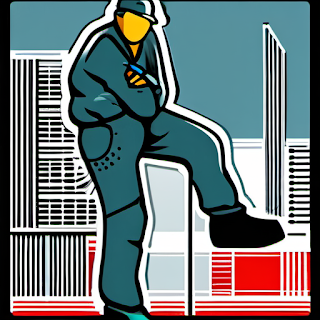I really enjoyed my first tutorial. I used the time to talk about two topics that had been troubling me.
Process art suggests that art should focus on the process, not the end result, and several people on the course have been advocating it, but I find myself fundamentally rejecting it
I spoke about my frustration that, for me, self-expression and meaning are central to art, and that the means of expressing those ideas is just that - a means to an end. Jonathan asked if I felt meanings were created or discovered. I expressed that they are (to me) discovered - sometimes they are discovered more 'upfront' e.g. something will strike me primarily as an idea e.g. my missing worker poster. Sometimes they are discovered as part of the process of experimenting with a more technique/medium-focused idea eg. my Britain 2050 - I wanted to play with the tree root, I didn't expect to create a piece of environmental satire, but was pleased that it had decided to be that. Jonathan suggested that what I had just described was my process! I laughed and agreed - but further pushed that my process was independent of the medium. Jonathan said he thought my direction and thinking we sound, but cautioned against:
1) Instrumentatisation - treating art as just a means to an end, devalued in the process
2) Loosing track of what I stand for, and myself in my art - which lead nicely to topic 2 below
3) Failing to keep reflecting on how this process can evolve and letting it evolve naturally
My take away was that my process is my process, and the proof it is in the art I do (or don't) create. However, there are two extremes to balance:
- Over-focus on process over production "doodling": Just doing whatever feels right and hoping great art emerges, but such art will potentially lack meaning - it will be just pleasing lines... Allowing the medium too much control at the expense of the artist
- Over-focus on production over process "diagramming" or instrumentalisation: Removing the medium from the process to the extent that you produce something dead and over-crafted. Allowing the artist too much control at the expense of the medium
However, I recognise and respect that some people work close to these extremes, and if that works for them all power to their elbow. I need to push ahead in the direction that makes sense to me, but recognise (as I think I do) that it may just be a phase!
What is Jonathan's reaction to my fucking inappropriate manifesto
Jonathan said it was interesting, and worth exploring to see where it takes me. I said I hoped to be a pain in everyone's arse in a good way!
Other thoughts
Jonathan suggested I check out:
We talked briefly about Jonathan's PhD, and student-led learning (my phrase), and the work of Carl Rodgers.



















.png)

.png)

